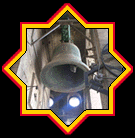
Miercoles, Day 10 - SevillaAfter a good night's sleep, we hit the road for Sevilla. Once again, we drove through the mountains, and saw mostly olive trees on carefully cultivated terraced mountainside for as far as the eye can see. Once we found our hotel in Seville, we headed out on foot to see the Catedral y Giralda. The Gothic Catedral was built mostly between 1401 and 1507, and is humungous - the Guinness Book of World Records reports that is has the largest church interior in all of Christiandom, and only St. Peter's at the Vatican and St. Paul's in London are larger from the outside. Like most Catholic churches in Andalucia, the Catedral was built on the site of an existing Mosque. Where the Mezquita in Córdoba is a mosque-turned-church that is still very much a mosque, the only remnants of mosque-ness in the Catedral y Giralda. are the Patio de Los Naranjos (Patio of Oranges) and the Giralda (tower) itself. Although since built up, the Giralda was the Minaret of the original mosque on this site, and was built in 1172. Today, it houses the cathedral's bells, and if you climb the 37 stories of gently ascending ramps - designed so that horses could climb to the top - you are rewarded with a magnificent view of the rest of the city. From there, it was a mere two minute walk to the highlight of our time in Sevilla - the Real Alcázar. The Alcázar is probably the best kept secret in all of Moorish Spain. It was built in 1366 by Pedro the Cruel, and is very much in the style of the Alhambra. It was later expanded by Charles the V and other Christian monarchs, but the main body of the complex retained its Moorish character. More importantly for our purposes, it has never been the subject of the kind of hype that the Alhambra has received since Washington Irving's visit, and as a result has many fewer tourists and is better preserved. For example, where the Alhambra's plaster work is mostly white, much of the plasterwork at the Alcázar has retained its elaborate paint work. After a nap, we had dinner at the restaurant in our hotel, El Burladero. (We Americanos were the first ones in the door when it finally opened at 9 pm). Since El Burladero has a bull-fighting theme, Dineen thought it was fitting to finish out her time in Spain with another helping of Rabo de Toro. It was here that we also had the most amazing olives we had ever tasted - tiny green babies still on the stem, not even old enough to have developed pits. They were absolutely delicious, and just popped in your mouth. And, of course, we had to end our time in Spain by ordering Gazpacho as an appetizer. I have so far resisted ranting on about Gazpacho, but I can't stop myself any longer. I had always liked well enough the chunky, tomato-y cold soup that passes for gazpacho in most American restaurants. But real, honest-to-God Andalusian Gazpacho is worlds better than the poor American counterpart. There are no chunks! It's not watery! Real Gazpacho has the consistency of a cream of tomato soup, but there is no cream in it at all. Rather, it is made of tomatoes, cucumbers, peppers, bread, and garlic, all pounded together with a mortar and pestle, thickened with olive oil and lightened with vinegar. Any chunks in it are added later - usually, the server will offer to garnish it with chopped onion, cucumber, croutons, and peppers. It is an absolutely amazing dish that should not be missed, but don't even bother ordering Gazpacho at a non-Spanish restaurant. You won't get the real thing. Since we've returned, Dineen has been searching for a recipe, so far to no avail (You'd think the likes of Martha Stewart and Williams-Sonoma would know better, but their Gazpacho recipes are all the awful chunky kind). So far, the only place we have found the real thing in DC is Taberna del Alabardero, an extremely pricey restaurant near Dineen's office downtown that has branches in Madrid, Sevilla and Marbella. Jueves, Day 11 - Sevilla y AdiósI know we named this little travelogue "Ten Days in Spain," but technically speaking we had a few hours to tour Seville on the eleventh day before we headed out to the airport. We got up early and walked from our hotel to Paseo de Cristobal Colón (Christopher Columbus Street) and journeyed southward along the Guadalquivir river. We walked past Sevilla's famous Plaza de Toros d la Maestranza (probably Spain's second oldest Bullring after Ronda's) and the 13th Century Torre del Oro (Tower of Gold), which got its name from the golden tiles that once decorated it. Finally, we reached our final destination: Parque de María Luisa. The park's namesake, Princess María Luisa, donated part of the grounds of the Palacio de San Telmo in 1893 to create this park for all of Sevilla to enjoy - sort of a Sevillian Central Park. And enjoy it we did - the lush landscaping and dancing fountains were absolutely beautiful. After a leisurely walk through the park, we reluctantly retraced our route back North along the river to our hotel, loaded up the car, and headed out to the airport. - Top - |
|